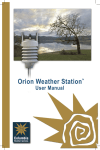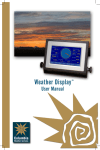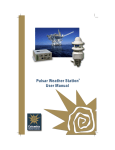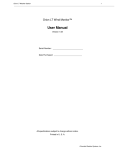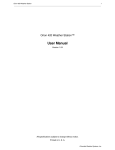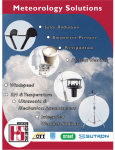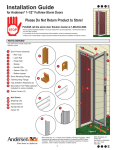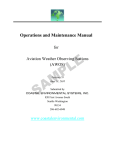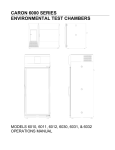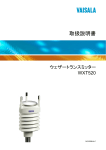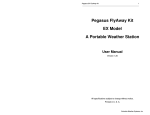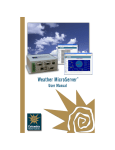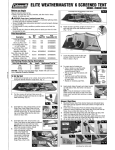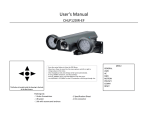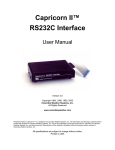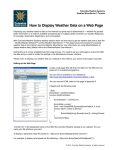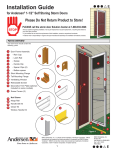Download Orion 420 Weather Station™
Transcript
Orion 420 Weather Station 1 ________________________________________________________________________ Orion 420 Weather Station™ User Manual Version 2.03 Serial Number: ___________________ Date Purchased: __________________ All specifications subject to change without notice. Printed in U. S. A. Columbia Weather Systems, Inc. 2 Orion 420 Weather Station ________________________________________________________________________ © Copyright 2005 - 2015 Columbia Weather Systems, Inc. All Rights Reserved. Proprietary Notice: Orion, Orion 420, Capricorn 2000, Capricorn 2000EX, Capricorn FLX, Magellan, Vela and Pulsar Weather Stations are trademarks of Columbia Weather Systems, Inc. The information and drawings contained herein are the sole property of Columbia Weather Systems, Inc. Use of this publication is reserved exclusively for customers of Columbia Weather Systems, Inc. and their personnel. Reproduction of this material is forbidden without the express written consent of Columbia Weather Systems, Inc. Parts of the Orion Weather Station™ user manual were adapted from the Weather Transmitter WXT520 User’s Guide with permission from Vaisala Oyj. WINDCAP®, RAINCAP®, HUMICAP®, BAROCAP® and THERMOCAP® are registered trademarks of Vaisala. Columbia Weather Systems, Inc. Orion 420 Weather Station 3 ________________________________________________________________________ Welcome! Congratulations on your purchase of an Orion 420 Weather Station. Please read this manual completely prior to installation. Columbia Weather Systems, Inc. 4 Orion 420 Weather Station ________________________________________________________________________ Columbia Weather Systems, Inc. Orion 420 Weather Station 5 ________________________________________________________________________ Important Notice: Shipping Damage BEFORE YOU READ ANY FURTHER, please inspect all system components for obvious shipping damage. The Orion is a high precision instrument and can be damaged by rough handling. Your unit was packaged to minimize the possibility of damage in transit. Please save the shipping container for any future shipment of your Orion sensor. In the event your order arrives in damaged condition, it is important that the following steps be taken immediately. The title transfers automatically to you, the customer, once the material is entrusted to the transport company. NOTE: DO NOT RETURN THE INSTRUMENT TO COLUMBIA WEATHER SYSTEMS until the following steps are completed. Failure to follow this request will jeopardize your claim. 1. Open the container and inspect the contents. Do not throw away the container or any damaged parts. Try to keep items in the same condition as originally received. 2. Notify the transport company immediately. 3. Request the transport company’s representative inspect the shipment personally. 4. After inspection, request a Return Materials Authorization (RMA) from Columbia Weather Systems by calling (503) 629-0887. 5. Return approved items to us at the following address: Columbia Weather Systems, Inc. 5285 NE Elam Young Parkway, Suite C100 Hillsboro, OR 97124 6. After a repair evaluation, an estimate of the cost of repair will be sent to you. Columbia Weather Systems, Inc. 6 Orion 420 Weather Station ________________________________________________________________________ ESD Protection Electrostatic Discharge (ESD) can cause immediate or latent damage to electronic circuits. Vaisala products are adequately protected against ESD for their intended use. However, it is possible to damage the product by delivering electrostatic discharges when touching, removing, or inserting any objects inside the equipment housing. To avoid delivering high static voltages yourself: 1. Handle ESD sensitive components on a properly grounded and protected ESD workbench. When this is not possible, ground yourself with a wrist strap and a resistive connection cord to the equipment chassis before touching the boards. When neither of the above is possible, at least touch a conductive part of the equipment chassis with your other hand before touching the boards. 2. Always hold the boards by the edges and avoid touching the component contacts. Columbia Weather Systems, Inc. Orion 420 Weather Station 7 ________________________________________________________________________ Table of Contents WELCOME! -------------------------------------------------------------- 3 IMPORTANT NOTICE: SHIPPING DAMAGE ----------------- 5 ESD PROTECTION ............................................................................................. 6 SECTION 1: INTRODUCTION ----------------------------------- 11 THE ORION 420 WEATHER STATION ............................................................... 11 SPECIFICATIONS .............................................................................................. 12 Operating Conditions................................................................................. 12 Wind Speed ................................................................................................ 12 Wind Direction ........................................................................................... 12 Relative Humidity....................................................................................... 12 Temperature ............................................................................................... 13 Barometric Pressure .................................................................................. 13 Precipitation .............................................................................................. 13 Input Voltage.............................................................................................. 13 Sensor Housing .......................................................................................... 14 Heating Power Source ............................................................................... 14 Serial to Analog Converters ....................................................................... 14 PRINCIPLES OF MEASUREMENTS ..................................................................... 15 Wind Measurement .................................................................................... 15 Pressure, Temperature, and Relative Humidity (PTU) Module ................. 16 Rainfall Measurement ................................................................................ 17 SECTION 2: PHYSICAL DESCRIPTION ---------------------- 19 ORION SENSOR TRANSMITTER ........................................................................ 19 Sensor Transmitter Components ................................................................ 19 Mounting Adapter ...................................................................................... 21 Internal Terminal Block ............................................................................. 21 Heating (Optional) ..................................................................................... 22 Orion 420 Enclosure .................................................................................. 23 SURGE/LIGHTNING PROTECTORS .................................................................... 24 SECTION 3: INSTALLATION ------------------------------------ 25 WEATHER STATION SYSTEM CONFIGURATIONS ............................................. 25 INSTALLATION OVERVIEW.............................................................................. 26 UNPACKING THE UNIT .................................................................................... 26 Installing the Mast ..................................................................................... 27 Location ..................................................................................................... 27 Mounting Method ....................................................................................... 27 Routing Cable ............................................................................................ 27 Installing the Orion Sensor Transmitter .................................................... 29 Columbia Weather Systems, Inc. 8 Orion 420 Weather Station ________________________________________________________________________ Site Selection .............................................................................................. 29 Installing the Mounting Adapter ................................................................ 29 North Alignment ......................................................................................... 30 Installing the Surge Arrestor...................................................................... 31 Connecting the Sensor Transmitter to the Orion 420 Enclosure ............... 32 Connecting the 420 Enclosure to the PLC ................................................. 33 SECTION 4: OPTIONAL MOUNTING HARDWARE ------ 35 Sensor Mast................................................................................................ 35 Roof Mounting ........................................................................................... 35 Wall Mounting ........................................................................................... 36 Telescoping Tripod and Tiedown Kit ......................................................... 38 Specifications ............................................................................................. 39 SECTION 5: OPERATION ----------------------------------------- 41 SECTION 6: MONITORING OPTIONS ------------------------ 43 WEATHER DISPLAY CONSOLE (OPTIONAL) .................................................... 44 WEATHER MICROSERVER (OPTIONAL) ........................................................... 45 WEATHERMASTER SOFTWARE (OPTIONAL) ................................................ 46 SECTION 7: MAINTENANCE ------------------------------------ 47 CLEANING....................................................................................................... 47 REPLACING THE PTU MODULE....................................................................... 47 FACTORY CALIBRATION AND REPAIR SERVICE .............................................. 48 SECTION 8: TROUBLESHOOTING ---------------------------- 49 Loss of communication with Orion sensor module: ................................... 50 Wind measurement failure: ........................................................................ 50 Pressure, humidity and temperature measurement failure: ....................... 50 SECTION 9: USER SUPPORT INFORMATION ------------- 51 LIMITED WARRANTY ...................................................................................... 51 EXCLUSIONS ............................................................................................ 51 RETURN FOR REPAIR PROCEDURE .................................................................. 52 REFERENCE ----------------------------------------------------------- 54 GLOSSARY ...................................................................................................... 54 Aspirating Radiation Shield ....................................................................... 54 Barometric Pressure .................................................................................. 54 Celsius Temperature Scale......................................................................... 54 Dew Point .................................................................................................. 54 Density Altitude.......................................................................................... 54 Fahrenheit Temperature Scale................................................................... 54 Global Radiation........................................................................................ 55 Columbia Weather Systems, Inc. Orion 420 Weather Station 9 ________________________________________________________________________ Heat Index .................................................................................................. 55 Pyranometer............................................................................................... 55 Relative Humidity....................................................................................... 55 Sea Level Pressure ..................................................................................... 55 Solar Radiation .......................................................................................... 55 Wind Chill .................................................................................................. 55 UNIT CONVERSION ......................................................................................... 56 Speed .......................................................................................................... 56 Temperature ............................................................................................... 56 Distance ..................................................................................................... 56 Pressure ..................................................................................................... 56 TABLES AND FORMULAS ................................................................................. 57 Wind Chill Chart ........................................................................................ 57 Wind Chill Equation .................................................................................. 58 Heat Index .................................................................................................. 59 Dew Point .................................................................................................. 60 Columbia Weather Systems, Inc. 10 Orion 420 Weather Station ________________________________________________________________________ Columbia Weather Systems, Inc. Orion 420 Weather Station 11 ________________________________________________________________________ SECTION 1: INTRODUCTION The Orion 420 Weather Station The Orion 420 weather station provides ultrasonic wind direction and speed measurements, a highly-accurate impact rain sensor, capacitive relative humidity, temperature and barometric pressure readings – all in a single sensor module. The Orion 420 provides 4-20mA current output for the eight weather parameters. High accuracy and fine resolution make this system ideal for precision weather monitoring. Columbia Weather Systems, Inc. 12 Orion 420 Weather Station ________________________________________________________________________ Specifications Operating Conditions Temperature Operation: -52 to +60°C (-61 to +140°F) Relative humidity: 0 to 100% Pressure: 600 to 1100 hPa Wind: 0 to 60 m/s Wind Speed Range: 0-135mph (0-60 m/s) Accuracy: ±3% at 10 m/s Resolution: 1 mph (1 m/s) Units Available: knots, mph, km/hr, m/s Wind Direction Azimuth: 0-360° Accuracy: ±3° Resolution: 1° Units Available: ° Azimuth Relative Humidity Range: 0 - 100% Accuracy: ±3% (0-90%), 5% (90-100%) Resolution: 1% Units Available: %RH Columbia Weather Systems, Inc. Orion 420 Weather Station 13 ________________________________________________________________________ Temperature Range: -60 to 140°F (-52 to +60°C) Accuracy: ±0.5°F (+/-0.3°C) at 68°F (+20°C) Resolution: 0.1°F Units Available: °F, °C Barometric Pressure Range: 17.50 to 32.50 InHg (600 to 1100 hPa) Accuracy: ±0.015 InHg (0.5 hPa) at +32 to 86°F (0 to 30°C) ±0.03 InHg (1 hPa) at -60 to 140°F (-52 to 60°C) Resolution: 0.01 InHg (0.1 hPa) Units Available: Kpa, mbar, InHg Precipitation Range: cumulative Collection Area: 602cm Accuracy: ±5% (spatial variations may exist) Resolution 0.01 in. (0.254mm) Units Available: mm, inches Input Voltage The Orion 420 is powered with an internal switching power supply Input: 120/240 VAC, 60 Hz Columbia Weather Systems, Inc. 14 Orion 420 Weather Station ________________________________________________________________________ Sensor Housing Protection class: IP66 (with mounting adapter) Materials: Polycarbonate + 20% glass fiber, stainless steel (AISI 316) Weight: 650 g (1.43 lbs) Heating Power Source Input: 5 to 30 VDC (1.1 A at 12 VDC) Serial to Analog Converters Analog Range: 4-20 mA Current sourcing Accuracy at 25°C: 0.1% of range Maximum load: 600 ohms Output reaction time: 0 – 40 ms DA Conversion: 12 bits (resolution 4096) Current Consumption: 30 mA to 120 mA Columbia Weather Systems, Inc. Orion 420 Weather Station 15 ________________________________________________________________________ Principles of Measurements Wind Measurement Both wind speed and direction are measured using advanced ultrasonic technology. The sensor utilizes ultrasound to determine horizontal wind readings. The array of three equally-spaced ultrasonic transducers on a horizontal plane is an ideal design that ensures accurate wind measurement from all directions, without blind angles or corrupted readings. The wind sensor has no moving parts, which makes it virtually maintenance free. Wind speed and wind directions are determined by measuring the time it takes the ultrasound to travel from each transducer to the other two. The wind sensor measures the transit time (in both directions) along the three paths established by the array of transducers. This transit time depends on the wind speed along the ultrasonic path. For zero wind speed, both the forward and reverse transit times are the same. With wind along the sound path, the up-wind direction transit time increases and the down-wind transit time decreases. The wind speed is calculated from the measured transit times using the following formula: Vw = 0.5 x L x (1/ tf – 1/tr) where: Vw = Wind speed L = Distance between the two transducers tf = Transit time in forward direction tr = Transit time in reverse direction Measuring the six transit times allows Vw to be computed for each of the three ultrasonic paths. The computed wind speeds are independent of altitude, temperature and humidity, which are cancelled out when the transit times are measured in both directions, although the individual transit times depend on these parameters. Using Vw values of two array paths is enough to compute wind speed and wind direction. A signal processing technique is used so that wind speed and wind direction are calculated from the two array paths of best quality. The wind speed is represented as a scalar speed in selected units (m/s, kt, mph, km/h). The wind direction is expressed in degrees (°). The wind Columbia Weather Systems, Inc. 16 Orion 420 Weather Station ________________________________________________________________________ direction reported indicates the direction that the wind comes from. North is represented as 0°, east as 90°, south as 180°, and west as 270°. The wind direction is not calculated when the wind speed drops below 0.05 m/s. In this case, the last calculated direction output remains until the wind speed increases again to the level of 0.05 m/s. The average values of wind speed and direction are calculated as a scalar average of all samples over the selected averaging time (1 ... 900 s). The sample count is based on a 4 Hz sampling rate. The minimum and maximum values of wind speed and direction represent the corresponding extremes during the averaging time. Pressure, Temperature, and Relative Humidity (PTU) Module Barometric pressure, temperature, and humidity measurements are combined in an advanced sensor module (PTU) utilizing a capacitive measurement method for each parameter. The PTU module contains separate sensors for pressure, temperature, and humidity measurement. The measurement principle of the pressure, temperature, and humidity sensors is based on an advanced RC oscillator and two reference capacitors against which the capacitance of the sensors is continuously measured. The microprocessor of the transmitter performs compensation for the temperature dependency of the pressure and humidity sensors. Barometric pressure is measured using a capacitive silicon BAROCAP® sensor. The sensor has minimal hysteresis and excellent repeatability, as well as outstanding temperature and long-term stability. Temperature is measured with a capacitive ceramic THERMOCAP® sensor. Relative humidity measurement is based on a capacitive thin film polymer HUMICAP®180 sensor. The sensor is highly accurate with negligible hysteresis and excellent long-term stability in a wide range of environments. Radiation Shield: This module is mounted in a specially-designed radiation shield which protects the sensors from both scattered and direct sunlight and precipitation. The composite material in the plates offers excellent thermal characteristics and UV stabilized construction. The white outer surface reflects radiation, while the black inside absorbs accumulated heat. The internal sensor module is easily replaceable and readily available as a spare component. To order a replacement module, please use catalog no. 9581. Columbia Weather Systems, Inc. Orion 420 Weather Station 17 ________________________________________________________________________ Rainfall Measurement Rainfall is measured with an impact sensor, which detects the size and impact of individual rain drops. The signals resulting from the impacts are proportional to the volume of the drops. Hence, the signal from each drop can be converted directly to the accumulated rainfall. This measurement method eliminates flooding and clogging, as well as wetting and evaporation losses. The sensor transmitter uses RAINCAP® sensor 2-technology in precipitation measurement. The precipitation sensor is comprised of a steel cover and a piezoelectric sensor mounted on the bottom surface of the cover. The precipitation sensor detects the impact of individual raindrops. The signals from the impact are proportional to the volume of the drops. Advanced noise filtering technique is used to filter out signals originating from other sources than raindrops. The measured parameter is accumulated rainfall. Detection of each individual drop enables computing of rain amount with high resolution. Columbia Weather Systems, Inc. 18 Orion 420 Weather Station ________________________________________________________________________ Columbia Weather Systems, Inc. Orion 420 Weather Station 19 ________________________________________________________________________ SECTION 2: PHYSICAL DESCRIPTION Orion Sensor Transmitter The Orion Sensor Transmitter is an all-in-one sensor unit containing ultrasonic wind speed and direction sensor, temperature sensor, relative humidity sensor, barometric pressure sensor and an impact rain sensor. The temperature, relative humidity and barometric pressure sensors are combined in a single module housed in a self-aspirating radiation shield. Sensor Transmitter Components 1: Top of the transmitter 2: Radiation Shield 3: Bottom of the transmitter 4: Screw cover Columbia Weather Systems, Inc. 20 Orion 420 Weather Station ________________________________________________________________________ Cut Away View 1: Wind Transducers (3 pcs) 2: Precipitation Sensor 3: Pressure sensor inside the Sensor Module 4: Humidity and temperature sensor inside the Sensor Module Bottom of the Transmitter 1: Alignment direction sign 2: Service port 3: Watertight cable gland 4: Unused cable gland, covered 5: Optional M12 connector Columbia Weather Systems, Inc. Orion 420 Weather Station 21 ________________________________________________________________________ Mounting Adapter To facilitate easy installation and north alignment, the Orion Sensor Transmitter comes standard with a mounting adapter. The mounting adapter is easily connected to the end of the mast and the sensor transmitter simply snaps into it. The north alignment needs to be performed only once. Internal Terminal Block The sensor transmitter is shipped with a one (1) foot cable terminated by an 8-pin connector half. This cable is connected to the sensor transmitter (at the factory) via a terminal block. 1: Grounding jumper (remove for ship marine applications). Columbia Weather Systems, Inc. 22 Orion 420 Weather Station ________________________________________________________________________ Heating (Optional) Heating elements located below the precipitation sensor and inside the wind transducers keeps the precipitation and wind sensors free from snow and ice. A heating temperature sensor (Th) underneath the precipitation sensor controls the heating. Note that (Th) is measured inside the transmitter, where temperature is much higher than the ambient temperature (Ta). Three fixed temperature limits, namely +4 °C, 0 °C, and -4 °C (+39 °F, +32 °F, +25 °F) control the heating power as follows: • When ambient temperature (Ta) falls below +4°C, heating is enabled. • Heating keeps Th > +4 °C until Ta < -1 °C • Heating keeps Th > 0 °C until Ta < -15 °C Columbia Weather Systems, Inc. Orion 420 Weather Station 23 ________________________________________________________________________ Orion 420 Enclosure The Orion 420 Enclosure contains the following: 1. AC power supply with +24 VDC output 2. AC power filter and suppressor 3. Two RS-232 to 4-20 mA converters 4. Sensor connection terminal block The enclosure used is UL 508 Type 4, NEMA/EEMAC Type 4. Enclosure flammability rating UL94-5V. Columbia Weather Systems, Inc. 24 Orion 420 Weather Station ________________________________________________________________________ Surge/Lightning Protectors A nearby lightning strike may induce a high voltage surge which the internal suppressor of your weather instrument may not be able to withstand, causing significant damage to the weather station. Protect your weather station investment with the Orion Surge Protector. This compact transient overvoltage suppressor is designed for weather stations in areas with an elevated risk of lightning strikes such as the top of high buildings, or installations with cable lengths greater than 100 feet. • Superior 3-stage surge protection • Tolerates up to 10kA surge currents • Both differential and common mode protection on each channel • Filtering against HF and RF noise • Two power channels and two data channels • Environmental protection class IP66 Catalog Number: 8355 Includes adjustable mounting kit Columbia Weather Systems, Inc. Orion 420 Weather Station 25 ________________________________________________________________________ SECTION 3: INSTALLATION Weather Station System Configurations Columbia Weather Systems, Inc. 26 Orion 420 Weather Station ________________________________________________________________________ Installation Overview Unpacking the System Installing the Mast Installing the Sensor Transmitter Installing the Surge Arrestor Installing the Orion 420 Weatherproof Enclosure Connecting the Sensor Transmitter to the enclosure Connecting the enclosure to the PLC Unpacking the Unit The sensor transmitter comes in a custom shipping container. Be careful when removing the device. CAUTION: Beware of damaging any of the wind transducers located at the top of the three antennas. Dropping the device can break or damage the transducers. If the antenna bends or twists, the re-aligning can be difficult or impossible. Unpack the Orion 420 weather station and verify that all parts are included. 1. Standard system includes: Orion Sensor Transmitter 50 ft sensor cable + additional cable length if ordered Orion 420 Weatherproof Enclosure User Manual Inspect all system components for obvious shipping damage (Refer to “Important Notice: Shipping Damage” in case of damage). Save the shipping carton and packing material in case the unit needs to be returned to the factory. If the system does not operate or calibrate properly, see Section 6: Maintenance and Section 7: Troubleshooting, for further instructions. Columbia Weather Systems, Inc. Orion 420 Weather Station 27 ________________________________________________________________________ Installing the Mast There are three acceptable methods for mounting the mast to a roof or building structure: Sloped roof mounting, flat roof mounting or wall mounting. See Optional Sensor Mounting Hardware for more information. Location Do not attach the sensor transmitter to a radio transmitting mast or tower. Select a mounting location that will allow the sensor cable to be routed away from other data cables to avoid interference. Do not mount sensors close to power lines. For normal roof mounting, the recommended minimum distance from power lines is 25 ft. (8 m). Use extreme caution when working close to power lines. Mounting Method Choose the appropriate mounting method for the installation and obtain any necessary mounting hardware. Refer to Optional Sensor Mounting Hardware section for information on optional sensor mounting hardware and accessories which are available from the factory. If the mounting hardware is not obtained from the factory, be certain to use metal parts which are plated or galvanized to assure maximum longevity. Secure the mast to the roof, using guy wires with sufficient tensile strength or to building wall using a wall-mount hardware kit. Routing Cable Use plastic tie wraps to secure the cable to mast, particularly at the mast base. Tighten the tie wraps securely and clip off any excess length with a wire cutter tool. Once the Orion sensor transmitter has been placed, route the cable back to the weatherproof enclosure. CAUTION: There may be electric wires in the wall. When routing cable through walls, we recommend that you shut off the electricity in the room(s) where you are drilling. Any mast or tower should always be properly earth grounded to minimize electrical storm damage. The use of a properly grounded metal mast or tower, however, does not insure protection from electrostatic discharge. These items could become electrically charged resulting in damage to Columbia Weather Systems, Inc. 28 Orion 420 Weather Station ________________________________________________________________________ the sensors and/or console. This could damage the system in the event of an electrical storm. Note: If the standard 50 ft. cable provided with the sensor transmitter is not long enough, it may be extended by splicing on an appropriate length of 22-gauge, stranded, seven conductor shielded cable with the same color code. When cutting and splicing, insure good contacts, proper color coding of the terminal leads, and a good seal. (A good solder splice, and water proof insulation are essential; merely twisting the respective wires together is not adequate.) Additional cable (Part No. 81547) is available from the factory. Columbia Weather Systems, Inc. Orion 420 Weather Station 29 ________________________________________________________________________ Installing the Orion Sensor Transmitter Site Selection Finding a suitable site for the sensor transmitter is important for getting representative ambient measurements. The site should represent the general area of interest. The sensor transmitter should be installed in a location that is free from turbulence caused by nearby objects, such as trees or buildings. WARNING: To protect personnel (and the device), a lightning rod should be installed with the tip at least 40 inches (one meter) above the sensor transmitter. The rod must be properly grounded, compliant with all local applicable safety regulations. Installing the Mounting Adapter 1. Insert the mounting adapter in the transmitter bottom side as shown in the diagram above. 2. Turn the adapter firmly until you feel that it has snapped into the locked position. 3. Align the transmitter in such a way that the arrow (at the bottom of the transmitter) points to north (see North Alignment). 4. Tighten the fixing screw to fix the adapter firmly to the mast. Columbia Weather Systems, Inc. 30 Orion 420 Weather Station ________________________________________________________________________ North Alignment To help with alignment, there is an arrow and text North on the bottom of the transmitter. The transmitter should be aligned in such a way that this arrow points to the north. Wind direction can be referenced to true north, which uses the earth’s geographic meridians, or magnetic north, which is read with a magnetic compass. The magnetic declination is the difference in degrees between the true north and magnetic north. Compass Alignment 1. If the sensor transmitter is already mounted, loosen the fixing screw on the mounting adapter. 2. Use a compass to determine that the transducer heads are exactly in line with the compass and that the arrow on the bottom of the transmitter points to north. 3. Tighten the fixing screw on the mounting adapter when done. Once the sensor transmitter is aligned to north, the transmitter can be removed from the mounting adapter without losing the north orientation. Columbia Weather Systems, Inc. Orion 420 Weather Station 31 ________________________________________________________________________ Installing the Surge Arrestor 1. Attach the unit to the mast close to the weather sensor with the adjustable mounting clamp, see figure above. 2. Slide the steel strip beneath the latch on the back of the enclosure. 3. Wrap the steel strip around the pole mast. You may shorten the strip to a suitable length. 4. Loosen the fastener by backing up the screw half way. 5. Attach the steel strip ends to the fastener by latching the fastener to a hole on the strip and folding it over. 6. Tighten the fastener’s screw in order to secure the unit to the pole. 2 7. Ground the unit using an AWG 6 (16 mm ) copper wire. Columbia Weather Systems, Inc. 32 Orion 420 Weather Station ________________________________________________________________________ Connecting the Sensor Transmitter to the Orion 420 Enclosure Using a #1 Straight Slot screwdriver, attach the wires from the end of the sensor cable to the terminal block screws as shown below: For heated sensor transmitters, connect the brown wire along with the red wire to position 1 and connect the blue wire along with the white and bare to terminal 2. Columbia Weather Systems, Inc. Orion 420 Weather Station 33 ________________________________________________________________________ Connecting the 420 Enclosure to the PLC 4-20mA cables are user supplied. The 4-20mA converters source power to the load. Columbia Weather Systems, Inc. 34 Orion 420 Weather Station ________________________________________________________________________ Columbia Weather Systems, Inc. Orion 420 Weather Station 35 ________________________________________________________________________ SECTION 4: OPTIONAL MOUNTING HARDWARE Sensor Mast 10-foot steel mast available for use with Roof Mount Hardware Kit (Part No. 88002) or Wall Mounting Kit (Part No.88003). Roof Mounting The Roof Mounting Kit (Part No. 88002) is suitable for both a slanted and flat roof installation. The figure and table below illustrates and describes the individual parts. Description Ref. Qty. Part No. Steel mast, 10 ft. 1 1 88005 Universal Mast Anchor 2 1 88010 Lag Screw, Roof Mast Mount 3 4 88030 4 1 88070 1/4" x 2 1/4" (for comp. roofs) Guy Wire Clamp, 1/8" Columbia Weather Systems, Inc. 36 Orion 420 Weather Station ________________________________________________________________________ Steel Guy Wire, Galvanized 6 50ft. 88080 Eye Bolt Wood Screws, 1/4" x 3" 7 4 88090 3 88100 Turnbuckles, 6" open x 4" closed (not shown) Wall Mounting The figure and table below illustrates and describes the individual parts in the Wall Mounting Kit (Catalog No. 88003). Individual parts are also available. Description Ref. Qty. Part No. Mast, 10 ft. 1 1 88005 4" Wall Mount Bracket 9 2 88120 Lag Screw 3 4 88030 Columbia Weather Systems, Inc. Orion 420 Weather Station 37 ________________________________________________________________________ Columbia Weather Systems, Inc. 38 Orion 420 Weather Station ________________________________________________________________________ Telescoping Tripod and Tiedown Kit The tripod is designed to provide up to 10 feet of stable, secure support for your meteorological sensors. Constructed from welded aluminum and powder coated for appearance and longevity, the 15-pound tripod can easily support up to 60 pounds of equipment. An optional tie-down kit allows for additional security in high-wind areas. To install, insert the legs into the main body and secure with stainless steel retainer pins. Extend the mast to the desired height and insert another retainer pin. Install the guy wires to complete the set-up. Columbia Weather Systems, Inc. Orion 420 Weather Station 39 ________________________________________________________________________ Tripod Parts List: Description Ref. Qty. Body/Mast Assembly 1 1 Legs 2 3 Retainer Pins 3 4 Guy Wire Ring with 3 Wires and Turnbuckles 4 1 Anchor Screw with Chain 5 1 Clamp with Strap 6 1 Specifications Capacity: Supports up to 60 lbs. Shipping Weight: 17 lbs Shipping Box Dimensions: 71" x 9" x 9" Tripod and Tiedown Kit Catalog Number: 88019 Columbia Weather Systems, Inc. 40 Orion 420 Weather Station ________________________________________________________________________ Columbia Weather Systems, Inc. Orion 420 Weather Station 41 ________________________________________________________________________ SECTION 5: OPERATION The Orion 420 outputs the following 8 parameters in 4-20 mA current signals: Channel 1: Wind Direction Description: Instantaneous wind direction. Range: 0 to 360 degrees Channel 2: Wind Speed Description: Instantaneous wind speed. Range: 0 to 135 mph Channel 3: Temperature Description: Instantaneous temperature. Range: -60 to +140°F Channel 4: Relative Humidity Description: Instantaneous relative humidity. Range: 0 to 100% Channel 5: Barometric Pressure Description: Instantaneous barometric pressure. Range: 17 to 33 inches Hg. Channel 6: Peak Wind Speed Description: Maximum wind speed in the last 1 second interval. Range: 0 to 135 mph Channel 7: Rainfall Description: 0.001 inches rain accumulation. The sensor internal counter will reset to zero inches when rainfall accumulation reaches 10.00 inches or when power to the sensor is lost. Range: 0 to 10.00 inches Channel 8: Rain Intensity Description: Instantaneous rain intensity. Running one minute average in 10-second steps. Range: 0 to 8 inches/hour Columbia Weather Systems, Inc. 42 Orion 420 Weather Station ________________________________________________________________________ Columbia Weather Systems, Inc. Orion 420 Weather Station 43 ________________________________________________________________________ SECTION 6: MONITORING OPTIONS In addition to the 4-20mA outputs the Orion 420 system can be configured to connect to optional weather monitoring devices. Columbia Weather Systems, Inc. 44 Orion 420 Weather Station ________________________________________________________________________ Weather Display Console (Optional) Displays weather information • Designed to be viewed clearly from a distance • Industrial grade WVGA touchscreen. Seven-inch, TFT color LCD panel with 800 x 480 pixel resolution. Performs computations for wind chill, heat index and other calculated parameters • 200MHz ARM9 CPU Serial or Ethernet connection: Connects directly to weather station with serial port or connects to a Weather MicroServer over a network utilizing an existing Ethernet infrastructure -- no extra wiring. The MicroServer configuration also allows for data from one weather station to be monitored from multiple display consoles at various locations. Screens can be factory-customized to meet specialized market and industry requirements. The Weather Display is also available in a 19” rack-mount chassis and a panel-mount configuration. Please refer to the Weather Display Console user manual for more information. Columbia Weather Systems, Inc. Orion 420 Weather Station 45 ________________________________________________________________________ Weather MicroServer (Optional) The Weather MicroServer uses a small computer board that runs an embedded Linux operating system. The MicroServer has 32MB flash memory for operation and 8 GB SD card for data logging. The Orion transmitter connects to the MicroServer via COM1. The MicroServer has two RS-232 COM ports and an Ethernet port. The MicroServer offers the following: • XML Weather Data • FTP weather data in XML or CSV format • Modbus/TCP, Modbus RTU (Serial RS-232), and Modbus ASCII interfaces • SNMP interface • Weather Underground & Anything Weather interface • CWOP interface • Three months of data logging at 1-minute interval • Interface to optional visibility and solar radiation sensors Columbia Weather Systems, Inc. 46 Orion 420 Weather Station ________________________________________________________________________ WeatherMaster Software (Optional) WeatherMaster is professional grade weather monitoring software. This software package is designed for specialized markets that require robust weather calculations, interoperability with computer models, and data interfaces to other industrial systems. WeatherMaster utilizes Microsoft Access database for easy data access and manipulation. Please refer to the WeatherMaster user manual for installation and operation procedures. Columbia Weather Systems, Inc. Orion 420 Weather Station 47 ________________________________________________________________________ SECTION 7: MAINTENANCE This chapter contains instructions for the basic maintenance of the sensor transmitter. Cleaning To ensure the accuracy of measurement results, the sensor transmitter should be cleaned when it becomes contaminated. Leaves and other such particles should be removed from the precipitation sensor and the transmitter should be cleaned carefully with a soft, lint-free cloth moistened with mild detergent. Replacing the PTU Module Note: Avoid contacting the white filter cap with your hands. Handle the PTU module from the plastic connector base (5). 1. Disconnect Orion sensor connector from cable and remove from mounting adapter. 2. Loosen the three screws at the bottom of sensor and slide out completely as shown below. Columbia Weather Systems, Inc. 48 Orion 420 Weather Station ________________________________________________________________________ 3. Remove the base section and disconnect the flat ribbon cable. 4. Pull out the top of the sensor. 5. Release the small white flap and remove the PTU module. 6. Connect a new PTU module, replace the top, re-connect the flat ribbon cable, replace the base and tighten the three bottom screws. 7. Re-install on mounting adapter and reconnect cable connector. Factory Calibration and Repair Service Send the device to Columbia Weather Systems, Inc. for calibration and adjustment, see Section 9: USER SUPPORT INFORMATION for more information. Columbia Weather Systems, Inc. Orion 420 Weather Station 49 ________________________________________________________________________ SECTION 8: TROUBLESHOOTING This chapter describes common problems, their probable causes and remedies. Problem Possible Cause Action Wind measurement failure. Both the speed and direction sensors are not reporting correct data Blockage (trash, leaves, branches, bird nests) between the wind transducers. Remove the blockage. Pressure, humidity or temperature measurement failure. PTU module may not be properly connected. There may be water in the PTU module. Ensure the proper connection of the PTU module. Loss of communication from Orion sensor module Blown fuse Check the Interface Module fuse, replace if needed. Check that the wind transducers are not damaged. Poor cable connection Surge protector tripped Remove and dry the module. Check all cable connections between sensor and optional monitoring device. Columbia Weather Systems, Inc. 50 Orion 420 Weather Station ________________________________________________________________________ Loss of communication with Orion sensor module: • Check the Interface Module. If the Green Power LED and Red Power LED are off then it is possible that the fuse has blown. Disconnect power and then remove the four screws on the front panel of the Interface Module to check the fuse. • Check all weatherproof cable connectors between the Orion sensor and any optional monitoring device, e.g., MicroServer, Display Console. Look for broken or damaged pins also inspect the cables connectors for water intrusion. • If a surge protector was purchased and installed, an electrical event may have tripped the surge. To determine if this is the reason for loss of communication, bypass the surge protector, reconnect the cables, and then check to see if communication has been reestablished. To purchase a replacement surge protector please call 1-503-629-0887 and reference Catalog No. 8355. Wind measurement failure: • If both the wind speed and direction sensors are not reporting correct data check to see if a blockage (trash, leaves, branches, bird nests) exists between the wind transducers. If this is the case remove the blockage and check to see if the wind reports have continued. Also check to see if the wind transducers are damaged. If they are damaged please follow the “Return for Repair Procedure” in Section 10. Pressure, humidity and temperature measurement failure: • The PTU module may not be properly connected. Ensure the proper connection of the PTU module by following the “Replacing PTU module” procedure in Section 8. There may be water in the PTU module. Remove and dry the module before reconnecting the sensor. Columbia Weather Systems, Inc. Orion 420 Weather Station 51 ________________________________________________________________________ SECTION 9: USER SUPPORT INFORMATION This section consists of the following items: 1. One-Year Limited Warranty: Please read this document carefully. 2. Return for Repair Procedure: This procedure is for your convenience in the event you must return your Orion for repair or replacement. Follow the packing instructions carefully to protect your instrument in transit. Limited Warranty Columbia Weather Systems, Inc. (CWS), warrants the Orion Weather Station to be free from defects in materials and/or workmanship when operated in accordance with the manufacturer’s operating instructions, for one (1) years from date of purchase, subject to the provisions contained herein. CWS warranty shall extend to the original purchaser only and shall be limited to factory repair or replacement of defective parts. EXCLUSIONS Certain parts are not manufactured by CWS (i.e., certain purchased options, etc.) and are therefore not covered by this warranty. These parts may be covered by warranties issued by their respective manufacturers and although CWS will not warrant these parts, CWS will act as agent for the administration of any such independent warranties during the term of this warranty. This warranty does not cover normal maintenance, damage resulting from improper use or repair, or abuse by the operator. Damage caused by lightning or other electrical discharge is specifically excluded. This warranty extends only to repair or replacement, and shall in no event extend to consequential damages. In the event of operator repair or replacement, this warranty shall cover neither the advisability of the repair undertaken, nor the sufficiency of the repair itself. THIS DOCUMENT REFLECTS THE ENTIRE AND EXCLUSIVE UNDERSTANDING OF THE PARTIES, AND EXCEPT AS OTHERWISE PROVIDED HEREIN, ALL OTHER WARRANTIES, EXPRESS OR IMPLIED, PARTICULARLY THE WARRANTIES OF MERCHANT ABILITY AND/OR FITNESS FOR A PARTICULAR PURPOSE ARE EXCLUDED. Columbia Weather Systems, Inc. 52 Orion 420 Weather Station ________________________________________________________________________ This warranty gives you specific legal rights, and you may also have other rights which vary from state to state. Return for Repair Procedure 1. In the event of defects or damage to your unit, first call the Service Department Monday through Friday, 8:30 am to 4:00 pm PST, (503) 629-0887 to determine the advisability of factory repair. The Service Department will issue an RMA number (Return Merchandise Authorization) to help us identify the package when received. Please write that number on the outside of the box. 2. In the event factory service is required, return your Orion Weather Station as follows: A. Packing Wrap the Sensor Transmitter in a plastic bag first. Pack in original shipping carton or a sturdy oversized carton. Use plenty of packing material. B. Include: A brief description of the problem with all known symptoms. Your telephone number. Your return street shipping address (UPS will not deliver to a P.O. box). Write the RMA number on the outside of the box. C. Shipping Send freight prepaid (UPS recommended). Insurance is recommended. (The factory can provide the current replacement value of the item being shipped for insurance purposes.) Columbia Weather Systems, Inc. Orion 420 Weather Station 53 ________________________________________________________________________ D. Send to: Columbia Weather Systems, Inc. 5285 NE Elam Young Parkway, Suite C100 Hillsboro, Oregon 97124 E. C.O.D. shipments will not be accepted. 3. If your unit is under warranty, after repair or replacement has been completed, it will be returned by a carrier and method chosen by Columbia Weather, Inc. to any destination within the continental U.S.A. If you desire some other specific form of conveyance or if you are located beyond these borders, then you must bear the additional cost of return shipment. 4. If your unit is not under warranty, we will call you with an estimate of the charges. If approved, your repaired unit will be returned after all charges, including parts, labor and return shipping and handling, have been paid. If not approved, your unit will be returned as is via UPS COD for the amount of the UPS COD freight charges. Columbia Weather Systems, Inc. 54 Orion 420 Weather Station ________________________________________________________________________ Reference Glossary Aspirating Radiation Shield A device used to shield a sensor such as a temperature probe from direct and indirect radiation and rain while providing access for ventilation. Barometric Pressure The pressure exerted by the atmosphere as a consequence of gravitational attraction exerted upon the “column” of air lying directly above the point in question. Celsius Temperature Scale A temperature scale with the ice point at 0 degrees and the boiling point of water at 100 degrees. Dew Point The temperature to which a given parcel of air must be cooled at constant pressure and constant water-vapor content in order for saturation to occur. When this temperature is below 0°C, it is sometimes called the frost point. Density Altitude Density altitude is a meteorological variable that is important to pilots, especially during the summer. The density altitude is the altitude in a standard atmosphere where the density is the same as the given atmospheric density. During a hot muggy summer day, a pilot begins take off from an airport with an elevation of 2500 feet. Because of the warm temperature and the moisture in the air, the airplane has to work as if it was taking off at an airport at an elevation of 6000 feet resulting in the plane needing more power and a longer roll down the runway to take off. Fahrenheit Temperature Scale A temperature scale with the ice point at 32 degrees and the boiling point of water at 212 degrees. Columbia Weather Systems, Inc. Orion 420 Weather Station 55 ________________________________________________________________________ Global Radiation The total of direct solar radiation and diffused sky radiation received by a unit horizontal surface. Global radiation is measured by a pyranometer. Heat Index The heat index or apparent temperature is a measure of discomfort due to the combination of heat and high humidity. It was developed in 1979 and is based on studies of evaporative skin cooling for combinations of temperature and humidity. Pyranometer It measures the combined intensity of incoming direct solar radiation and diffused sky radiation. The pyranometer consists of a radiation-sensing element, which is mounted so that it views the entire sky. Relative Humidity Popularly called humidity. The ratio of the actual vapor pressure of the air to the saturation vapor pressure. Sea Level Pressure The atmospheric pressure at mean sea level, either directly measured or, most commonly, empirically determined from the observed station pressure. In regions where the earth’s surface pressure is above sea level, it is standard observational practice to reduce the observed surface pressure to the value that would exist at a point at sea level directly below. Solar Radiation The total electromagnetic radiation emitted by the sun. 99% of the sun’s energy output falls within the wavelength interval from 0.15 microns to 4.0 microns, with peak intensity near 0.47 microns. About one-half of the total energy in the solar beam is contained within the visible spectrum from 0.4 to 0.7 microns, and most of the other half lies near infrared, a small additional portion lying in the ultraviolet. Wind Chill That part of the total cooling of a body caused by air motion. Columbia Weather Systems, Inc. 56 Orion 420 Weather Station ________________________________________________________________________ Unit Conversion Speed Kilometers per hour = 1.610 x miles per hour Knots = 0.869 x miles per hour Meters per second = 0.448 x miles per hour Feet per second = 1.467 x miles per hour Temperature Temperature in °C = 5/9 (temperature in °F - 32) Temperature in °F = (1.8 x temperature in °C) + 32 Distance Millimeters = 25.4 x inches Pressure Millibars = 33.86 x inches of mercury Kilopascals = 3.386 x inches of mercury Pounds per square inch = 0.49 x inches of mercury Standard atmospheres = 0.0334 x inches of mercury Columbia Weather Systems, Inc. Orion 420 Weather Station 57 ________________________________________________________________________ Tables and Formulas Wind Chill Chart In 2001, NWS implemented an updated Wind chill Temperature (WCT) index. The change improves upon the former WCT Index used by the NWS and the Meteorological Services of Canada, which was based on the 1945 Siple and Passel Index. In the fall of 2000, the Office of the Federal Coordinator for Meteorological Services and Supporting Research (OFCM) formed a group consisting of several Federal agencies, MSC, the academic community (Indiana University-Purdue University in Indianapolis (IUPUI), University of Delaware and University of Missouri), and the International Society of Biometeorology to evaluate and improve the windchill formula. The group, chaired by the NWS, is called the Joint Action Group for temperature Indices (JAG/TI). JAG/TI's goal is to upgrade and standardize the index for temperature extremes internationally (e.g. Wind chill Index). The current formula uses advances in science, technology, and computer modeling to provide a more accurate, understandable, and useful formula for calculating the dangers from winter winds and freezing temperatures. Columbia Weather Systems, Inc. 58 Orion 420 Weather Station ________________________________________________________________________ Wind Chill Equation WC = 35.74 + 0.6215 T -35.75(V 0.16 ) + 0.4275 T(V 0.16 ) Where: WC = wind chill temperature in °F V = wind velocity in mph T = air temperature in °F Note: Wind chill Temperature is only defined for temperatures at or below 50 degrees F and wind speeds above 3 mph. Columbia Weather Systems, Inc. Orion 420 Weather Station 59 ________________________________________________________________________ Heat Index Temperature in °F 70 75 80 85 90 95 100 105 110 115 120 125 130 135 0 64 66 73 78 83 87 91 95 99 5 64 69 74 79 84 88 93 97 102 107 111 116 122 126 10 65 70 75 80 85 90 95 100 105 111 116 123 131 15 65 71 76 81 86 91 97 102 108 115 123 131 20 66 72 77 82 87 93 99 105 112 120 130 141 25 66 72 77 83 88 94 101 109 117 127 139 30 67 73 78 84 90 96 104 113 123 135 148 35 67 73 79 85 91 98 107 118 130 143 40 68 74 79 86 93 101 110 123 137 151 45 68 74 80 87 95 104 115 129 143 50 69 75 81 88 96 107 120 135 150 55 69 75 81 89 98 110 126 142 60 70 76 82 90 100 114 132 149 65 70 76 83 91 102 119 138 70 70 77 84 93 106 124 144 75 70 77 85 95 109 130 150 80 71 78 86 97 113 136 85 71 78 87 99 117 140 90 71 79 88 102 122 150 95 71 79 89 105 126 100 72 80 90 108 131 RH 103 107 111 117 120 Columbia Weather Systems, Inc. 60 Orion 420 Weather Station ________________________________________________________________________ Dew Point B = (ln (RH/100) + ((17.2694*T) / (238.3+T))) / 17.2694 Dew Point in °C = (238.3 * B) / (1-B) Where: RH = Relative Humidity T = Temperature in °C Ln = Natural logarithm Columbia Weather Systems, Inc. Orion 420 Weather Station 61 ________________________________________________________________________ Columbia Weather Systems, Inc. 5285 NE Elam Young Parkway, Suite C100 Hillsboro, OR 97124 Telephone (503) 629-0887 Fax (503) 629-0898 Web Site http://www.columbiaweather.com Email [email protected] Catalog Number: 81655 Version 2.03 Printed in U.S.A. Columbia Weather Systems, Inc.





























































